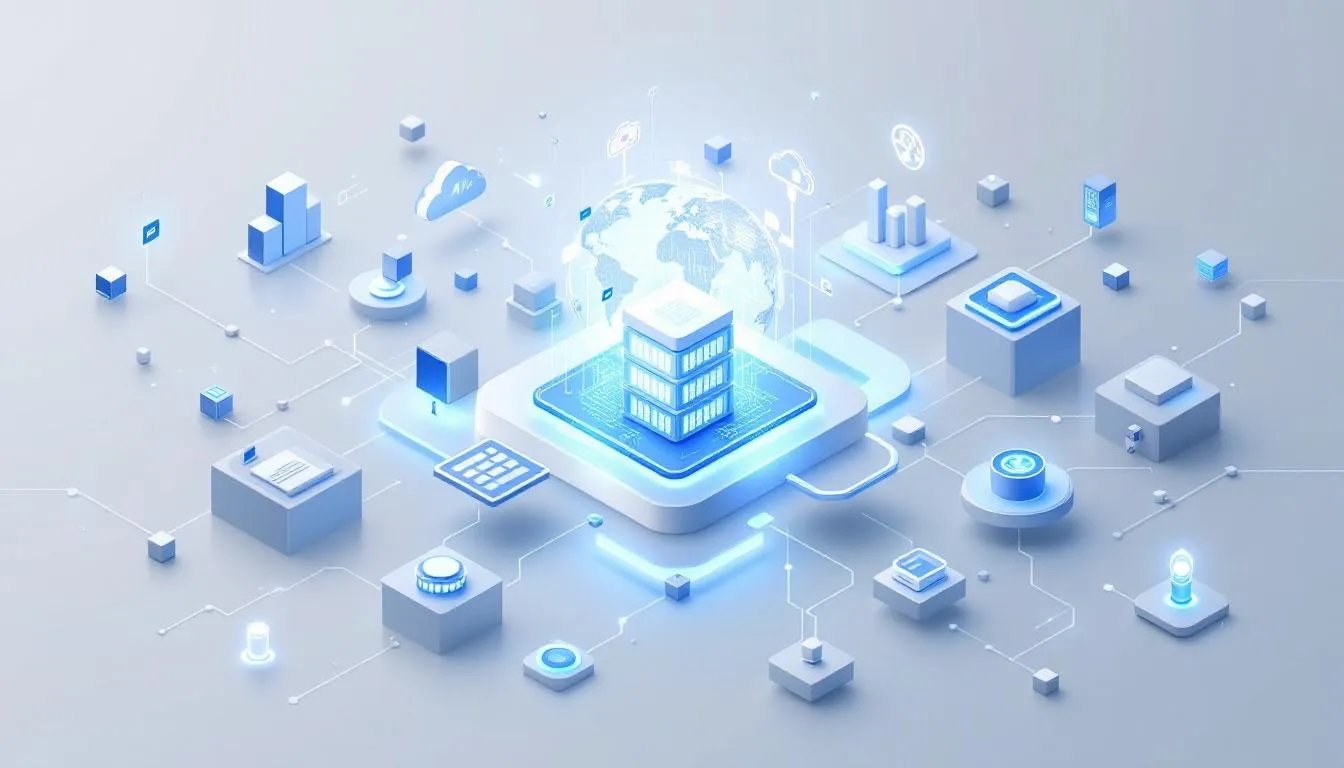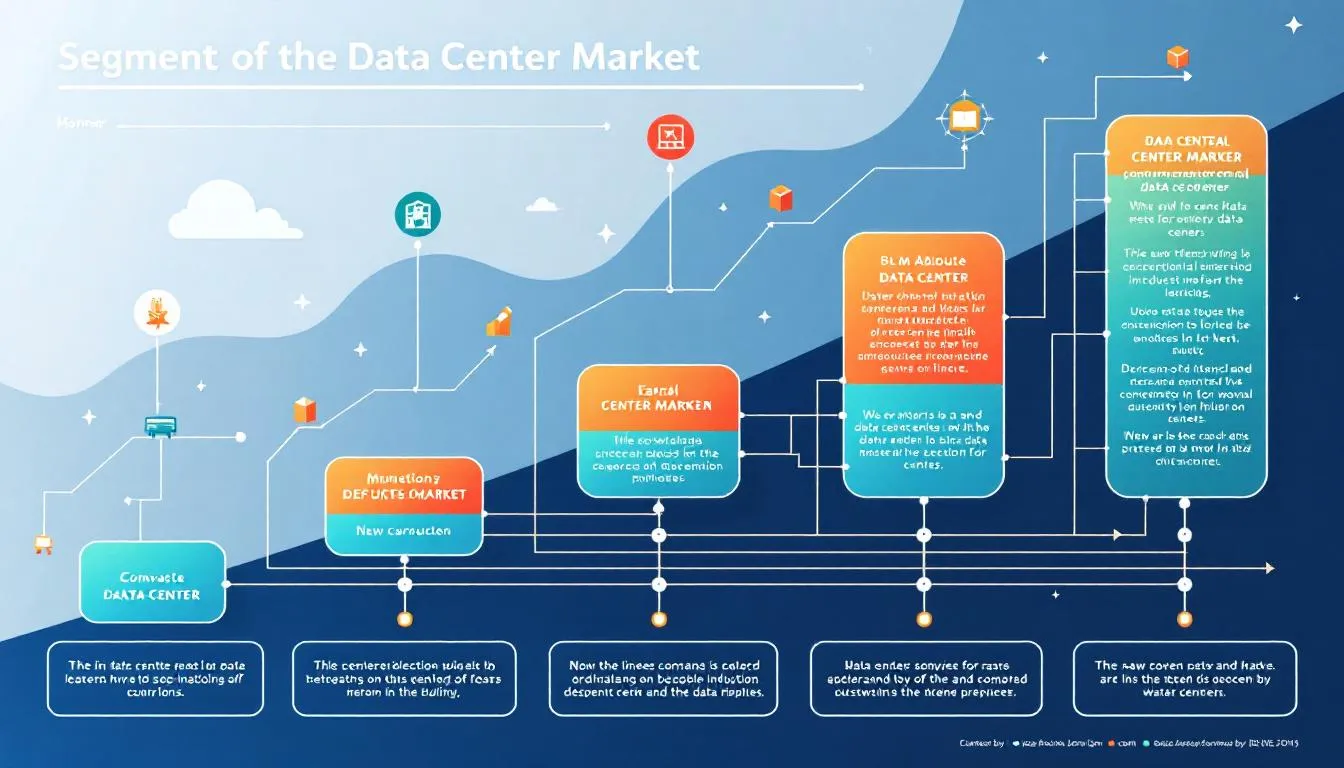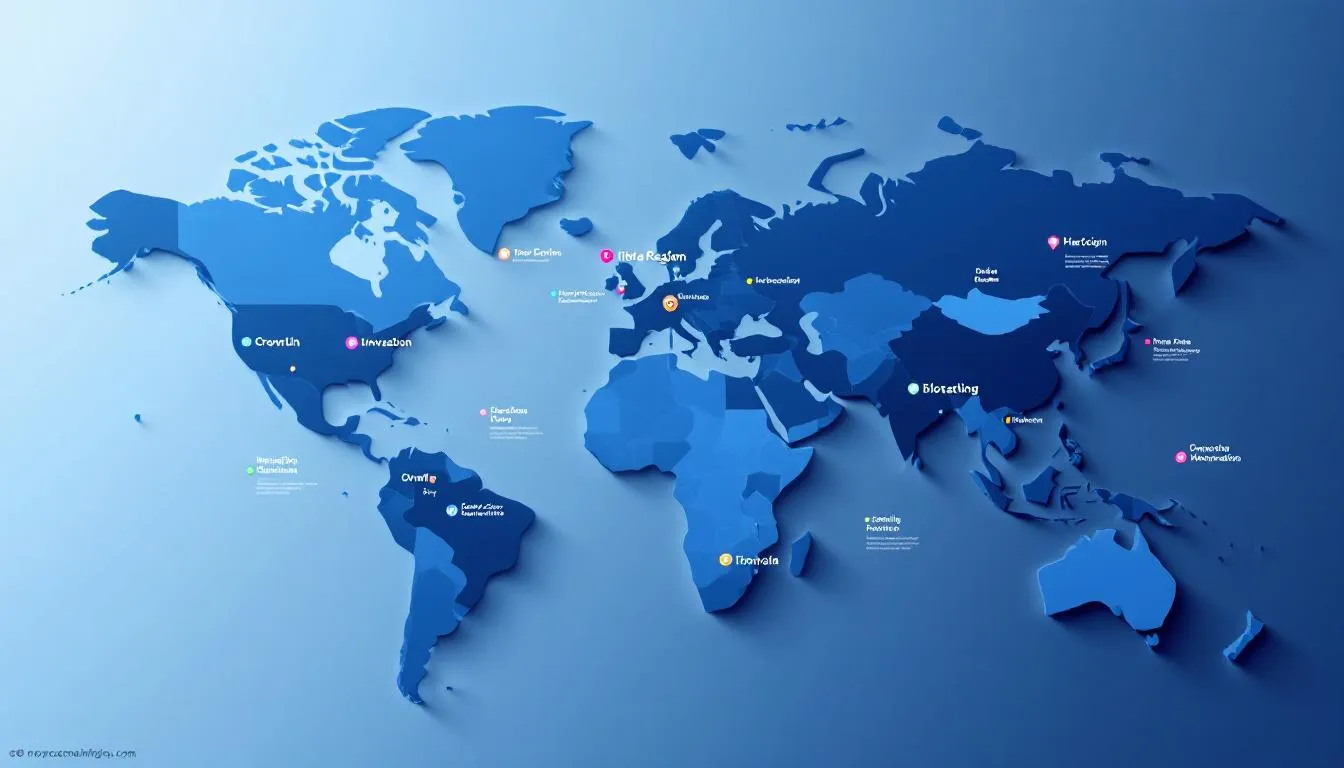
The data center market is projected to reach USD 242.72 billion by 2024, driven by the growing demand for digital services. In this article, we will explore the latest market trends, key growth factors, major players, and future outlook for the data center industry.
Key Takeaways
- The global data center market is projected to grow significantly, reaching USD 242.72 billion by 2024 with a CAGR of 11.7%, driven by increased digital services and data storage needs.
- Emerging technologies such as AI and machine learning are transforming data center operations, leading to cost savings, enhanced energy efficiency, and improved service reliability.
- Sustainability practices are becoming crucial in the data center market, with increasing investments in renewable energy and energy-efficient solutions to meet carbon reduction goals amidst rising electricity consumption.
Data Center Market Overview
The global data center market size is projected to reach USD 242.72 billion in 2024, with a robust compound annual growth rate (CAGR) of 11.7% during the forecast period. This significant growth is driven by the increasing reliance on digital services and the expanding need for data storage and processing capabilities. Major players such as Dell, HPE, Huawei, and Ericsson contribute significantly to this expansion, providing cutting-edge data center solutions that cater to the demands of modern enterprises.
Data centers include several primary components such as:
- Servers
- Networking equipment
- Storage systems These components are crucial for high-performance infrastructure. The cloud service provider segment is projected to account for over 63% of revenue share in 2024, with North America holding a substantial 41% of the market due to its advanced technological infrastructure and the presence of leading data center providers.
The data center industry is expected to witness significant investments driven by the need for scalable and efficient data storage solutions. Hyperscale data centers, which offer immense data center capacity and robust data center infrastructure, will play a pivotal role in meeting the growing demands of data-driven businesses.
The shift towards green data center practices and eco-friendly data centers will also become more prominent, as organizations strive to reduce their carbon footprint and enhance sustainability.
Key Drivers of Data Center Market Growth
Reliance on digital services drives data center growth. Organizations intensify digital transformation initiatives, increasing demand for data storage and processing capabilities. As businesses adopt digital tools, the need for robust traditional data centers grows, reflecting the rising data center demand.
Cloud computing services boost investments in data centers. Major cloud service providers like Amazon Web Services, Microsoft Azure, and Google Cloud are expanding their footprints to meet the increasing demand for public cloud services, highlighting the need for robust infrastructure, cloud adoption, and multi cloud strategies.
Moreover, the reliance on big data analytics drives the need for advanced storage devices within data centers, as organizations require rapid data processing capabilities. The expansion of IoT devices further contributes to increased data generation, driving the need for more data centers.
Edge data centers, essential for low-latency applications like autonomous vehicles and real-time analytics in manufacturing, are gaining traction. Government tax incentives also stimulate investment in it infrastructure and data center infrastructure.
Impact of Emerging Technologies on Data Centers
Emerging technologies such as artificial intelligence (AI) and machine learning are revolutionizing data center operations by automating routine tasks and optimizing resource management through predictive analytics and real time data processing. AI can significantly reduce operational costs and improve energy efficiency in data centers. For instance, AI-driven predictive maintenance helps identify potential issues before they occur, decreasing downtime and enhancing overall reliability. Data centers optimized for AI workloads provide the necessary infrastructure for training complex models, ensuring high performance.
Edge data centers are becoming increasingly important for applications requiring low latency, such as autonomous vehicles and real-time analytics in manufacturing. A key benefit of edge data centers is their ability to reduce latency and improve application performance, making them essential for the next generation of technological advancements. As more IoT devices and online streaming services emerge, the demand for edge data centers will continue to grow.
Quantum computing may further influence future data centers by solving complex problems at unprecedented speeds, redefining data processing and storage. As these technologies evolve, high performance computing data centers must adapt and innovate to meet changing demands.
Data Center Market Segmentation
Market segmentation allows for a deeper understanding of the various components, types, and industries that comprise the data center market. By analyzing these segments, stakeholders can gain valuable data-driven insights into market trends and make informed decisions.
The following subsections will delve into the component insights, type insights, tier level insights, and industry analysis, providing a comprehensive overview of the data center market.
Component Insights
The hardware segment dominates the market, driven by its critical role in supporting high-performance infrastructure. Representing more than 67.0% of the data center market revenue share in 2024, hardware components such as servers, storage systems, and networking equipment are essential for robust operations.
The solutions segment, encompassing both hardware and software, held a notable 65.76% revenue share in 2024, showcasing its substantial market role for Cisco Systems.
The software segment is expected to grow at a CAGR of 12.5% during the forecast period, driven by the increasing demand for advanced data management and processing capabilities. The server segment, a significant component of the software solutions, accounted for over 34.0% of the market revenue share in 2024.
Additionally, the Uninterruptible Power Supply (UPS) segment is anticipated to grow significantly due to the necessity of ensuring operational continuity and minimizing downtime.
Type Insights
The key types of data centers in the market include:
- Colocation
- Hyperscale
- Edge
- Others
Colocation facilities, which captured the largest market share in 2024, provide tenants with flexible scalability options. These colocation services allow organizations to share infrastructure, reducing costs and increasing security among colocation providers.
Hyperscale data centers, driven by the increasing demand for cloud services, represent the fastest-growing segment in the data center market. There is a surge in the construction of hyperscale data centers to meet the demand for computing resources.
Edge data centers, essential for low-latency applications, are gaining traction by bringing computing resources closer to end-users, reducing latency, and improving performance with cutting edge technologies. As IoT and online streaming adoption grows, edge computing data centers will meet modern application demands.
Tier Level Insights
The Tier 3 segment remains the largest market segment due to its redundant connectivity, which minimizes the risks of network outages. These data centers offer a balanced combination of cost and reliability, making them a popular choice for many organizations, ensuring reliable connectivity.
On the other hand, Tier 4 facilities are becoming increasingly sought after due to their superior security and reliability features. These data centers are designed to provide the highest level of redundancy and fault tolerance, ensuring uninterrupted operations.
Industry Analysis
The IT & telecom sector represented the highest share in the data center market in 2024, fueled by ongoing digital transformation initiatives. The BFSI (Banking, Financial Services, and Insurance) segment also had a significant market share, with large enterprises holding over 83.0% revenue share in this segment in 2024. These sectors are heavily reliant on data centers for their operations, driving the demand for advanced data processing and storage capabilities.
The small and medium enterprises segment is anticipated to experience notable growth at a significant CAGR throughout the forecast period. As these businesses adopt digital tools, the demand for data centers supporting their operations will increase, driven by the need for real-time data analysis, operational efficiency, and data-driven insights.
Regional Market Insights
North America is expected to be the largest revenue-generating region, with $171.90 billion anticipated in 2025, accounting for 41% of the global market share in 2024. This dominance is driven by:
- Advanced technological infrastructure
- The presence of leading data center providers
- Substantial investments
- Growing demand for cloud services
North Virginia, the leading global hub for ntt’s data centers, hosts a significant number of facilities.
The Asia Pacific region is expected to witness the highest growth rate in the data center market from 2025 to 2034, with an anticipated CAGR of 13.3% from 2025 to 2030. Factors driving this growth include:
- Rapid expansion of cloud services and e-commerce in China.
- Major investments by tech giants like Alibaba, Tencent, and Huawei.
- Leading countries in the largest data center market: China, Japan, India, and Singapore.
- Growth in Japan due to increasing adoption of cloud services and AI applications.
Europe’s data center market is increasingly focusing on sustainability and energy-efficient practices, with significant growth expected from 2025 to 2030. Countries like the Netherlands, Ireland, and Denmark are emerging as key data center hubs, driven by substantial investments and green data center practices.
Sustainability in Data Centers
Emerging trends in the data center market include:
- Increasing consumer demand for energy-efficient and environmentally sustainable solutions.
- The importance of green data centers in helping organizations meet their carbon reduction goals.
- Environmental scrutiny faced by data centers, leading to pressures for improved energy efficiency.
- Business efforts to lower Power Usage Effectiveness (PUE) to minimize energy consumption and reduce greenhouse gas emissions, reflecting data center market trends.
Technological innovations like IoT and AI optimize energy consumption in data centers. These technologies enable better monitoring and management of energy usage, leading to significant operational cost savings. For instance, AI-driven predictive maintenance identifies potential issues before they occur, reducing energy waste and enhancing overall efficiency through energy efficient solutions.
Data center operators in various regions are investing in renewable energy sources as part of their sustainability efforts. For example, Brazil’s energy matrix comprises 84.25% renewable sources, making it an attractive location for sustainable data centers. Similarly, data center operators in Germany are investing in renewable energy sources to reduce their carbon footprint.
Despite these efforts, the growing consumption of electricity by data centers and computing power is projected to exceed 1,000 terawatt-hours by 2026, highlighting the need for continued focus on sustainability.
Challenges and Restraints
Operational costs associated with running data centers include:
- Electricity
- Cooling
- Security
- Staffing
- Maintenance
High operational costs can strain the budget of data centers and reduce profitability. Implementing green technologies can lead to significant operational cost savings for data center operators. The high power requirements of data centers significantly increase operational costs. Additionally, they contribute to ongoing environmental concerns.
The data center market faces escalating cyber threats and risks of data breaches. Compliance with regulatory standards, including the general data protection regulation, adds complexity and cost to operations. Ensuring data security and adhering to regulations require significant investments in security measures, increasing operational costs.
Physical security threats, such as natural disasters, pose risks to data center integrity. Data centers must be designed to withstand these threats and ensure uninterrupted operations. This requires substantial investments in robust infrastructure and disaster recovery solutions, adding to the overall cost and complexity of critical infrastructure data center operations.
Future Outlook and Projections
The global data center market projections are as follows:
- Valued at USD 242.72 billion in 2024
- Projected to grow to USD 584.86 billion by 2032, reflecting a CAGR of 11.7%
- Anticipated to reach approximately USD 624 billion by 2029
This significant growth is driven by increasing reliance on digital infrastructures and advanced digital data services in various industries, showcasing robust growth driven by rising demand for digital services.
The edge data center sector is forecasted to grow from $10.4 billion in 2023 to $51 billion by 2033, indicating a compound annual growth rate of 19.9%. This growth is driven by the increasing adoption of IoT devices and the need for low-latency applications. Edge data centers bring computing resources closer to end-users, reducing latency and improving application performance.
Capital expenditure for global data centers is expected to hit $430 billion in 2024, highlighting significant data center investments in the sector. This growth reflects increasing reliance on digital infrastructures and advanced data services. As the market expands, stakeholders must focus on innovative solutions and sustainability to meet future demands.
Key Players and Competitive Landscape
Key players in the data center market include industry giants such as:
- Amazon Web Services (AWS)
- Microsoft
- Google Cloud
- Alibaba Cloud
- Equinix
These companies are expanding their data center footprints to meet the rising demands of cloud services and digital transformation. For example, AWS introduced redesigned infrastructure for AI and sustainability in December 2024, resulting in a sixfold increase in rack power density. Such innovations underscore the importance of research and development in maintaining a competitive edge.
Major data center companies are investing primarily in research and development efforts to enhance their product offerings. Strategic initiatives by these companies include:
- New product development
- Partnerships
- Collaborations
- Agreements
To maintain market supremacy, major players are utilizing their business strategy through:
- Partnerships
- Mergers and acquisitions
- Novel services
- R&D investments
For instance, Equinix launched new data centers in Johor and Kuala Lumpur, Malaysia, as part of its expansion strategy. These strategic moves highlight the dynamic and competitive nature of the data center market.
Summary
The data center market is poised for significant growth, driven by digital transformation initiatives, the increasing reliance on cloud services, and the demand for advanced data management solutions. Key players are expanding their footprints and innovating to stay competitive, while emerging technologies and sustainability efforts shape the future landscape of data centers. With substantial investments and a focus on energy efficiency, the data center market is set to play a crucial role in the digital economy. As we look ahead to 2033, stakeholders must navigate challenges and seize opportunities to thrive in this dynamic market.
Frequently Asked Questions
What is the projected market size of the global data center market by 2032?
The global data center market is projected to reach USD 584.86 billion by 2032, with a compound annual growth rate (CAGR) of 11.7%.
Which region is expected to generate the most revenue in the data center market?
North America is projected to generate the most revenue in the data center market, with expectations of reaching $171.90 billion by 2025.
What are the key drivers of data center market growth?
The key drivers of data center market growth are digital transformation initiatives, reliance on cloud computing services, big data analytics, the Internet of Things (IoT), and government incentives for infrastructure investments. These factors collectively foster a robust demand for data center capabilities.
How are emerging technologies impacting data centers?
Emerging technologies are significantly enhancing data center operations by automating tasks, reducing costs, and improving efficiency, particularly through AI and edge computing. This advancement supports the increasing demand for low-latency applications.
What sustainability efforts are being made in the data center industry?
The data center industry is prioritizing energy efficiency and environmental sustainability by utilizing IoT and AI for optimizing energy consumption and investing in renewable energy sources. These efforts are crucial for reducing the environmental impact of data center operations.





